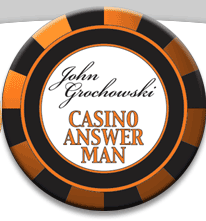In the race to see which is more cluttered, my home office or the
corner of my mind that collects little pieces of gambling history,
well, I guess my home office wins hands down. Nonetheless, bits of
trivia are trying to escape, so let's empty a little of the clutter:
**The slang expression rolling the bones
has an origin that is quite literal. Dice were carved from bones for
thousands of years. It was not at all unusual in Roman times for dice
to be fashioned from sheep's knuckles.
Dice have been made
from wood, clay, stone, peach pits, animal horns, teeth, ivory,
bronze, porcelain, even jewels. The oldest known dice with regular
sides were found in northern Iraq. They're made of baked clay and date
to about 3,000 B.C.
**Coin-operated gaming devices in the
late 1800s included games with large revolving wheels divided into
color segments. Players wagered on which color the wheel would stop.
They're considered the forerunners of modern slot machines, even though
they didn't have reels. The first recognizably modern three-reel slot
was the Liberty Bell, invented by Charles Fey in San Francisco in 1899.
The machine was so popular that for many years all slot machines were
referred to as bell machines.
The bar symbol used
on modern slot machines is derived from a Bell Fruit Gum logo. The gum
was dispensed in slots designed by Herbert Mills in Chicago in 1910,
and other fruit symbols on slots were derived from the gum flavors.
Among the most popular early slots were poker games, although the
machines did not usually pay out coins. Payoffs had to come from the
operator. After the introduction of the Liberty Bell, poker-based
slots waned in popularity, until the invention of video poker in the
1970s.
**The game of 21 got its common nickname, blackjack,
from a practice in illegal casinos in the early 1900s. Some casinos
paid a bonus if a two-card 21 was made up of an ace and jack of
spades. Others paid bonuses if an ace of spades was accompanied by a
jack of either clubs or spades. The black jack was the key to the
bonus, and became the name of the game.
Less commonly used
nicknames for the game of 21 include Pontoon and Van John. Both arose
in the South, probably around illegal casinos in New Orleans. Both
nicknames probably are corruptions of the pronunciation of the French
game vingt-un, which means "21" and is believed by some to be a
blackjack forerunner.
**Horizontal gaming wheels, such as those used in roulette, were invented in England in 1720 for a game called roly-poly.
Roly-poly was similar to roulette, except there were no numbers on the
wheel. There were alternating white spaces and black spaces, along
with a "bar black" space and a "bar white" space. The "bar" spaces were
the equivalents of zero and double-zero -- if the ball landed in
either space, bets on black or white lost.
Roly-poly was
banned in England in 1745, but the horizontal wheel traveled well. By
1796, modern roulette was being played in France.
**The kings in decks of playing cards represent real leaders and conquerors from history, although not all had the title of king.
The deck we use today is based on cards designed in 15th-century
France. The king of spades represents the Biblical King David, the
king of clubs represents Alexander the Great, the king of hearts
represents Charlemagne and the king of diamonds represents Julius
Caesar.
The four suits represent civilizations that have
influenced our culture. Spades represent the Middle East of Biblical
times, clubs represent Greece, diamonds represent the Roman Empire, and
hearts represent the Holy Roman Empire.
Perfect for Caesars Palace, don't you think?

that's really thorough and filled with a bunch of names I don't know and a few I do.casino winners
ReplyDelete